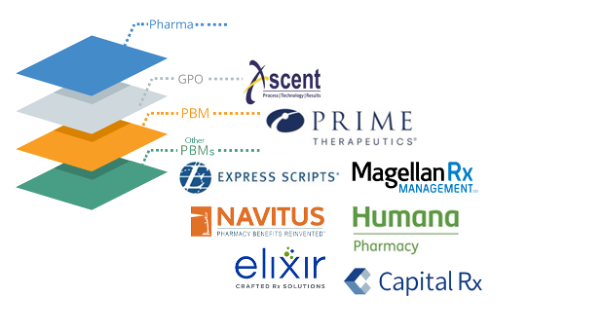PBM GPOs—Does Your PBM Have a GPO and Do You Know Who They Are? (The Answers are “Yes” and Likely “No”)
Traditional Pharmacy Benefit Managers (PBMs) are intentionally opaque with their pricing. The language surrounding their programs speak on behalf of optimization and lower costs, yet upon dissecting the contracts, various pools of profit are being created to help PBMs and their shareholders—driving up costs for employers and patients. Self-funded employers are promised rebates and discounts when signing with a PBM, yet costs continually increase each year. One culprit incentivizing these rising costs may be the PBM’s use of a group purchasing organization (GPO).
GPOs are utilized in various categories within the health care realm. Other industries are learning how GPOs work too—like grocery, electronics, manufacturing and agriculture. So, what benefits do they provide these industries?
How GPOs Work
A group purchasing organization leverages the purchasing power of group businesses. Vendor discounts can be obtained by collectively buying pharmaceuticals in bulk alongside other GPO members. This is a great practice in theory, but the discounts seen do not often translate to savings for self-funded employers and their members served by the pharmacy benefit manager.
In fact, PBM GPOs themselves don’t actually buy anything; they were only created to have a new revenue stream and shelter PBMs from transparency and reporting.
PBMs make money through rebates, admin fees and spread. These practices all coincide with how GPOs work; when these two organizations work together, additional funds are allocated for their profit rather than price cuts for the consumer.
Much of this is hidden within the intricate web of overseas corporations. The GPOs associated with the “Big 3” traditional PBMs are Ascent (Switzerland), Emisar (Ireland) and Zinc (U.S.). Due to the nature of many GPOs being offshore, they are able to decrease their tax implications to the U.S. government, adding another layer of complexity to an already complex industry.
One of the “Big 3” traditional GPOs, Ascent, is a prime example. Ascent holds the pharma manufacturer agreements, allowing the PBM to deny contract review. By creating a new legal entity that holds the contracts, the PBM relieves itself of any responsibility, providing a shelter where PBMs can say, “we don’t have any contracts to review.”
This creates a blind spot for employers working with the PBM. (Do you know which GPO your PBM uses? You should.) They’re aggregating the buying power to get better rebates. Can your consultant and PBM show you drug-by-drug how the rebates are affecting your business and what you’re getting? If not, you should question whether this is the right deal for you.

Additionally, their employee base is next-to-none despite being considered a multi-million-dollar company… Take the challenge — research and see if you can find any employees for these PBM GPOs online! How can you run a company that brings in tens of billions of dollars with no electronic footprint, overhead or employee presence on social media?
All in all, GPOs make transparency difficult—for the consumers, policymakers, self-funded employers and even the U.S. pharmaceutical manufacturers—the entire pharmacy industry.
While the state of Florida signed an executive order requiring PBMs to monitor circumvented profit activity and pass the collection of rebates over to the employers, GPOs are not required to do the same. How GPOs work for the health care industry is by intentionally blurring pharmaceutical costs. This only makes the black box bigger.
Has your PBM told you about this GPO layer? Do you know of their fee structures or their employee base? When asking these questions, be sure to see the rebates and net spend for the last three years to compare whether the GPO helps drive rebates or saves you money. You may be surprised by what you find.
As you’re talking to fellow self-funded benefit leaders, compare numbers:

The reality is, there are millions more being kept and no employer is getting the best deal.
AffirmedRx is Working Hard to Eliminate the GPO Layer
AffirmedRx aims to provide a different financial model tailored towards patients rather than profits. By removing the GPO layer and giving employers data access, clarity and program insights are gained. In the AffirmedRx Model, a GPO entity does not profit from additional admin fees; employers can see on the claim level what manufacturers are contributing to drive down the costs of pharmaceuticals.
Working with AffirmedRx equips employers with a direct line from a PBM to a pharmaceutical company. There is no more wondering how GPOs work and what your money is going towards. Work with one of the 10 Most Trustworthy Companies of 2022, AffirmedRx.

